On March 2011, the crisis in Syria took place and is still going on until today, it has caused
several upsetting consequences to the Syrian citizens. Approximately 7.5 million individuals are
rearranged in the country, and more than 4 million Syrian have left to live in nearby countries
including Lebanon (1.2 million refugee) (Blanchet, Fouad, & Pherali, 2016). Post-migration
conditions for Syrian refugees are extremely poor, including lack of physical health services,
insufficient household, prejudice, and fear about what is yet to come (Lies, Drummond, & Jobson,
2020). Studies revealed that these issues have a negative influence on psychological wellbeing,
with a prevalence 27.2% for PTSD (Lies et al., 2020).
Resiliency is known as the capacity of human beings of all ages to adapt, settle, and rise
above a permanent or short-lived complexity. This trait has also been found to be a shield that
protects a person from having mental disorders. Furthermore, other researchers define resilience
to be a character trait that is associated with the decrease of disorder and it can be a predictor of a
healthy mind (Alduraidi, Dardas, & Price, 2020). Studies have found that people who score higher
on resiliency are more likely to develop better coping strategies. According to Windle (2011),
people with weak emotional or behavioral capabilities, but did suffer, are resilient. If an individual
maintains their regular performance after a traumatic life experience, they are resilient (Alduraidi
et al., 2020).
Several researches have affirmed that adaptable people have lower risk of experiencing
PTSD signs post trauma. In addition, it was established that these people use a larger number of
instrumental coping techniques and request help from the community. People with strong PTSD
adaptability have better mental immunity acquiring mental problems and have a higher chance to
go back to former degree of competence than those who have poor posttraumatic resistance
(Thompson, Fiorillo, Rothbaum, Ressler, & Michopoulos, 2018).
The research question concerning this study is « Does being exposed to a war-trauma make
a person more resilient in future stressful events?”. In order to be able to answer this question, a
number of data was collected and evaluated with the help of Power BI. This application is a group
of tools, resources, and connections that operate together just to transform your diverse sources of
data into cohesive, engaging visuals, and dynamic findings.
1. Resiliency after trauma
Resiliency is known as the capacity of human beings of all ages to adapt, settle, and rise
above a permanent or short-lived complexity. This trait has also been found to be a shield that
protects a person from having mental disorders. Furthermore, other researchers define resilience
to be a character trait that is associated with the decrease of disorder and it can be a predictor of a
healthy mind (Alduraidi et al., 2020). According to the researchers, resiliency is really not merely
the inverse of risk factors, but instead the traits and systems that an individual brings that serve to
safeguard them from acquiring psychiatric diseases. Furthermore, those with adaptable characters reported less PTSD symptoms after being exposed to combat zone shocks than those who scored
poorly on the resilience aspects of regulations (Alduraidi et al., 2020).
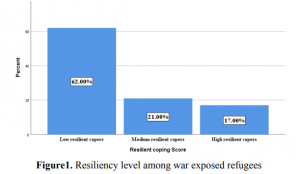
As shown in Figure 1., most Syrian refugees who have are victims of the war (N=50)
scored low resiliency after the trauma. Therefore, they were not able to adapt properly after the
explosion. Results show that 62% shave low resiliency levels, 21% have a medium level, while
only 17% scored a high resiliency characteristic.
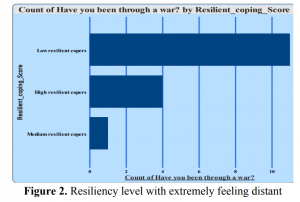
An item from the questionnaire was selected to analyzed in correlation to being through a
war, only answers who were “extremely” to the entry feeling distant it cut off from people were
studied here. As the Figure 2. shows, 11 of those who felt extremely detached from their social
surrounding had low resiliency, 4 showed high resiliency, while only 1 person had a medium level.
2. Anxiety after trauma
Studies have shown that people who have been diagnosed with depression or anxiety disorder, or
have a hereditary record of neuroticism are more at risk of developing PTSD after being exposed
to a trauma. Statistics from « The National Comorbidity Survey » confirmed that 88.3 percent of
males and 79.0 percent of females with PTSD have a higher possibility of suffering from at least
one more mental disorder.Furthermore, a study on Iraqi soldiers that went through battles showed
that 15.6% to 17.1% were diagnosed with Major Depressive Disorder, Generalized Anxiety
Disorder, and PTSD (Thompson et al., 2018).
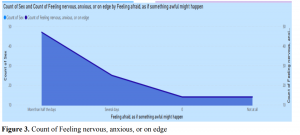
Analysis were made to study the level of
anxiety in all participants (N=100). In general, most
participants showed a high level of anxiety
regardless if they have a prior trauma or not. Results
indicated that 48 of participants put “more than half
the days” to questions regarding being anxious,
nervous, or on edge. While those who put “several
days” were 22, and 30 participant selected “not at all”
in the questionnaire. (shown in Figure 3.)
Figure 4. Anxiety level among war exposed
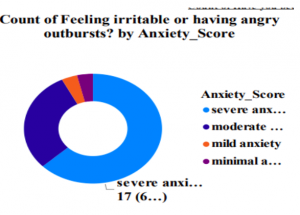
In this study, we selected refugees who were exposed to a war before and examined their
anxiety levels after a subsequent trauma. Data has found, as shown in Figure 4., that 17
participants had severe anxiety after the explosion, which indicates the low level of resiliency and
adaptability. Among participants, 13 showed moderate anxiety, and equally 10 individuals had
mild anxiety with the last 10 showing minimal anxiety.
3. Does Gender play a role in predicting resiliency levels?
This study is distributed randomly, thus explains the inequality between the numbers of
male and female participants. Females were outnumbering Males, with 56 of respondents being
women and the other 44 were men. (shown in Figure 5.)
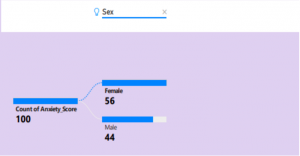
Figure 5. Gender of participants
An item was chosen from the Resileincy questionnaire to compare nervousness between
men and women. As Figure 6. illustrates, an equal number of males and females answered with
feeling nervous for several days of the week. While the difference is notable when it comes to
feeling nervous for more than half the days of the week, with 25 women and only 7 men. Also
men who did not feel nervous at all were more (15), and only 10 women choosing this option.
Therefore, we can conclude that females have a higher tendency to adapt poorly to stressful
situations, while men tend to be more resilient in nature.
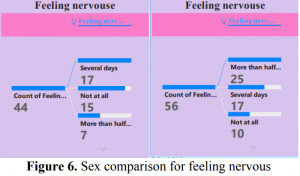
REFERENCES
Alduraidi, H., Dardas, L. A., & Price, M. M. (2020). Social determinants of RESILIENCE
AMONG Syrian refugees in Jordan. Journal of Psychosocial Nursing and Mental Health
Services, 58(8), 31-38.
Blanchet, K., Fouad, F. M., & Pherali, T. (n.d.). Syrian refugees in Lebanon: The search for
universal health coverage. Conflict and Health, 2016th ser. doi:10.1186/s13031-016-0079-
4
Lies, J., Drummond, S. P., & Jobson, L. (2020). Longitudinal investigation of the
relationships between trauma exposure, post-migration stress, sleep disturbance, and
mental health in Syrian refugees. European Journal of Psychotraumatology, 11(1),
1825166. https://doi.org/10.1080/20008198.2020.1825166
Thompson, N. J., Fiorillo, D., Rothbaum, B. O., Ressler, K. J., & Michopoulos, V. (2018). Coping
strategies as mediators in relation to resilience and posttraumatic stress disorder. Journal of
Affective Disorders, 225, 153–159. https://doi.org/10.1016/j.jad.2017.08.049
